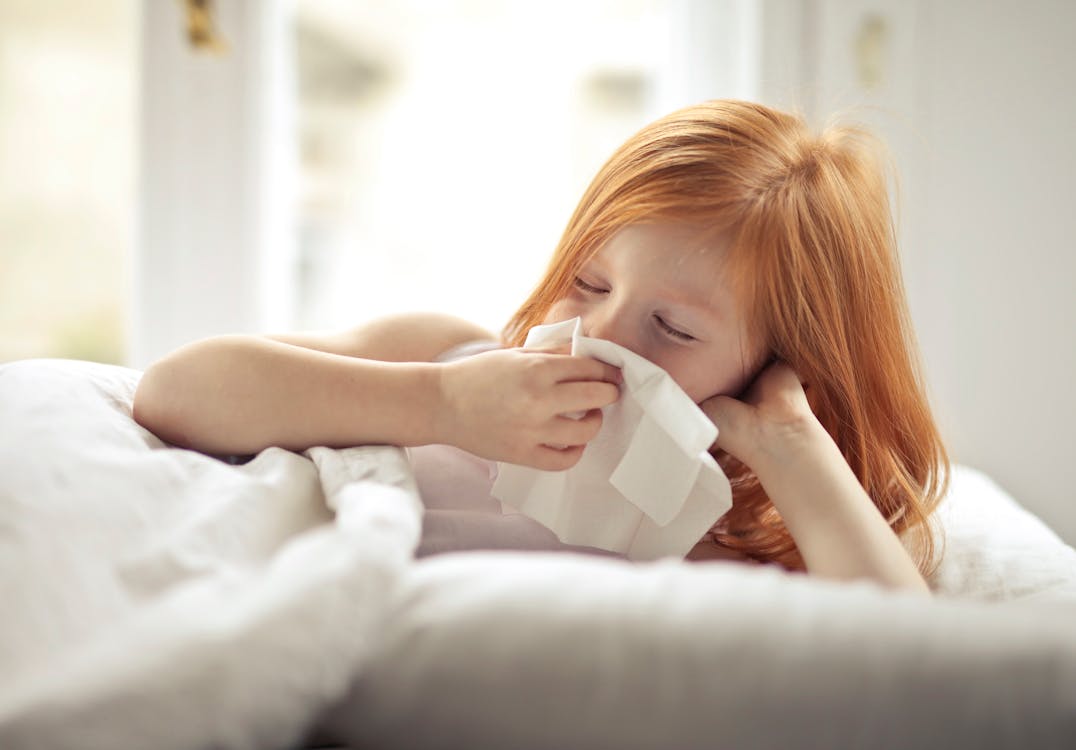Bacterial infections like Staphylococcus aureus cause it in kids and adults. In children, nasal vestibulitis can cause pain, redness, swelling, and tenderness. Children may also have fever, nasal discharge, and trouble breathing. In severe situations, the infection might cause an abscess that needs surgical draining.
Preventing complications and improving outcomes requires early nasal vestibulitis detection and treatment. The infection can spread to the sinuses and create major health issues if left untreated. Antibiotics and painkillers, nasal sprays, and warm compresses are used to treat the bacterial infection.
Parents and carers should know the symptoms of nasal vestibulitis in children and seek medical help if their child exhibits them. Most children recover from nasal vestibulitis without complications with treatment.
Infant and Toddler Nasal Vestibulitis: Causes and Risk Factors

Nasal vestibulitis is a common condition that can have a variety of root causes and disproportionately affects children. Reasons why children may be at risk for developing nasal vestibulitis and what can be done to prevent it are discussed below.
Staphylococcus aureus bacteria
Infection with Staphylococcus aureus bacteria is the most prevalent cause of nasal vestibulitis. There are germs in the environment that can enter the nasal cavity through abrasions or cuts in the skin within the nose.
Children can get the bacteria into their noses by picking their noses, rubbing their noses, or touching objects that have been contaminated. Nasal vestibulitis in children is frequently caused by Staphylococcus aureus, a highly dangerous and rapidly distributed bacterium.
Physical injury or trauma
Nasal vestibulitis in children can also be caused by physical injury or trauma to the nose. Accidental contact with an object, a slip and fall, or a physical activity can all lead to injuries. The impact may produce abrasions or wounds inside the nose, which can then get infected with bacteria.
Irritation from nasal sprays, chemicals or allergies
Nasal vestibulitis in children can also be caused by irritation of the nasal lining brought on by allergies, chemical exposure, or the use of nasal sprays. An allergic reaction can produce swelling and inflammation in the nasal passages, which can eventually cause the lining to break down.
Nasal lining inflammation and irritation can also be brought on by exposure to chemical irritants including cleaning chemicals, air pollution, and tobacco smoke. Nasal sprays and drops, if used repeatedly, can irritate and even damage the nasal lining.
Underlying medical conditions
Nasal vestibulitis is more common in children who already have a preexisting medical problem, like a compromised immune system, diabetes, or chronic sinusitis. Nasal infections are common in people with compromised immune systems, as these factors allow bacteria to more easily penetrate the nose cavity.
Poor hygiene
Children are more likely to develop nasal vestibulitis if they engage in poor hygiene practises such not washing their hands frequently or sharing personal belongings like towels, pillows, and toys.
This is due to the fact that Staphylococcus aureus germs are capable of surviving on hard surfaces and objects for long periods of time and are easily transmitted from person to person.
Symptoms of Nasal Vestibulitis in Children

1. Pain, redness, and swelling in the nasal vestibule
Symptoms of nasal vestibulitis in children include tenderness, redness, and swelling in the nasal passages. This might be distressing for the kid, who may find relief by rubbing or touching the area regularly.
Depending on how severe the inflammation is, the pain could be moderate to severe, and it could be accompanied with a stuffy or clogged feeling in the nose.
2. Crusting, scabbing, and bleeding
Dry, itchy skin is a common side effect of inflammation in the nasal vestibule. Crusts or scabs may form as a result, and picking at them or otherwise disrupting them can be very unpleasant and even cause bleeding.
Oozing or drainage from the nose is also a common symptom of nasal vestibulitis in children.
3. Nasal discharge and itching
The nasal vestibulitis symptoms in children include nasal drainage. Its discharge might be watery thin or thick and viscous. Sometimes the discharge is clean, and other times it has a slight yellowish tint.
Nasal vestibulitis can cause itching in the nose and the space right inside the nostrils in children.
4. Sore throat and cough
Some people with nasal vestibulitis also have secondary symptoms like a sore throat and cough. Inflammation in the back of the throat or inhalation of nasal discharge can also contribute to this condition in children.
A dry or productive cough may accompany the sore throat and a feeling of scratchiness or irritation may be present.
These symptoms may also be brought on by allergies, sinus infections, or even the regular cold. Get medical attention to discover the reason of your child’s symptoms and get them treated if necessary.
Diagnosis of Nasal Vestibulitis in Children

A combination of a physical exam, assessment of the patient’s medical history, culture and sensitivity tests, and a biopsy is required to diagnose nasal vestibulitis in children.
1. Physical examination
The doctor will look in the child’s nostrils and surrounding them. Redness, swelling, crusting, and discharge in the nasal vestibule are all things they will be on the lookout for.
When checking for infection or inflammation, the doctor may also use a nasal speculum to peek up the patient’s nostrils.
2. Medical history review
The doctor will inquire from both the child and their parents about the child’s current state of health, specifically if the child has been suffering any discomfort, itching, or nasal discharge.
They will inquire about previous health issues, medications, and allergies that may be playing a role in the current condition.
3. Culture and sensitivity tests
A nasal swab may be taken by the doctor and sent to the lab for bacterial culture and sensitivity testing.
By determining the specific bacteria or fungus responsible for the infection, this test can assist prescribe the most appropriate antibiotic or antifungal medicine.
4. Biopsy
The doctor may take a sample of the damaged tissue from the vestibular nares in some circumstances. This requires surgical removal of a microscopic sample of tissue for microscopic analysis.
Nasal polyps and tumours can be ruled out as possible causes of symptoms by performing a biopsy to confirm a diagnosis of vestibulitis in the nose.
Nasal vestibulitis in children is diagnosed after a careful physical examination, evaluation of the patient’s medical history, and, in some cases, laboratory tests and biopsy. If your child is displaying signs of nasal vestibulitis, it is crucial that you take them to the doctor so that the underlying reason may be identified and the child can receive treatment.
Nasal Vestibulitis in Children: Possible Treatments

Antibiotic ointments or creams
To treat bacterial infections in the nasal vestibule, it may be necessary to apply an antibiotic ointment or cream directly to the affected area. Inflammation, redness, and swelling can be mitigated by using these, which can be recommended by a doctor.
Oral antibiotics
Sometimes, however, oral antibiotics are required because the illness is more severe or has migrated to other parts of the body. Culture and sensitivity tests will reveal the precise infection cause, which will then guide the choice of antibiotic.
Pain relief medications
Pain relievers like acetaminophen and ibuprofen, available without a prescription, may be suggested.
Nasal saline washes
Nasal irrigation with saline solution helps alleviate inflammation and stuffiness in the nose. This kind of thing is either available without a doctor’s prescription or at a pharmacy near you.
Warm compresses
A warm compress applied to the area might help alleviate discomfort and speed recovery. Using a warm, damp washcloth to the area for several minutes multiple times a day is recommended.
Steam inhalation
Nasal congestion can be eased and healing facilitated by the use of steam inhalation. A youngster can inhale steam by having a warm shower or bath or by utilizing a humidifier or vaporizer.
To avoid a relapse, it’s crucial to stick to the approved treatment plan and take the whole course of antibiotics if they’ve been prescribed. Get medical attention if your symptoms persist or worsen. If an infection is really stubborn or keeps coming back, surgery may be the only option.
Protecting Young Children From Nasal Vestibulitis

Proper hygiene, education, not sharing personal objects, determining and treating underlying medical issues, and immune system strengthening are all important in preventing nasal vestibulitis in youngsters.
1. Proper nasal hygiene
Maintaining a clean and healthy nasal passageway is an important part of good nasal hygiene. You can accomplish this by eliminating the practise of picking your nose and by routinely cleansing your nose with a saline nasal wash or spray.
The development of bacteria and fungus, which can cause vestibulitis in the nose, can be stymied with regular nasal hygiene practices.
2. Teaching youngsters proper sanitation techniques
Teaching youngsters the value of personal hygiene in stopping the spread of disease is crucial. If a child coughs or sneezes, they should cover their mouth and nose, they should not touch their face, and they should wash their hands frequently.
3. Avoiding sharing personal items
Infections are more likely to spread when people share towels, washcloths, and tissues. I think it’s important to teach kids to use their own stuff and not share with others.
4. Detecting and treating medical issues
Nasal vestibulitis is more likely to occur in people who already have underlying medical issues, like allergies or chronic sinusitis. In order to reduce the risk of infection, it is crucial to diagnose and treat these disorders.
5. Boosting the immune system
Having a robust immune system is crucial for staying healthy and fighting off infections. Remind kids of the importance of maintaining a healthy lifestyle by eating right, getting plenty of rest, and being active. Stay away from secondhand smoke and other immune-suppressing toxins.
In conclusion, proper hygiene, education, not sharing personal objects, recognising and treating underlying medical issues, and boosting the immune system can all aid in preventing nasal vestibulitis in children. When you take care of your nose like this, you lower your child’s chance of getting nasal vestibulitis.
When to Consider Pediatric Nasal Vestibulitis Treatment
Most cases of paediatric nasal vestibulitis respond well to home care, including good hygiene, topical treatments, and antibiotics if necessary. Yet, it’s possible that you’ll need medical help. If your child exhibits any of the following symptoms, it is important for you to get them checked out by a doctor:
1. Severe pain and inflammation
The youngster should see a doctor if the pain and inflammation are severe and don’t respond to home care. These signs could point to a more serious infection or the need for more potent treatment.
2. High fever and chills
Very high temperatures and chills may point to a more serious infection or the spread of infection outside the nasal vestibule. This needs to be dealt with immediately by a medical professional.
3. Worsening symptoms despite treatment
Get medical help if the child’s symptoms persist or worsen despite treatment. A drug adjustment or additional testing could be necessary.
4. Signs of spreading infection
Get prompt medical assistance if redness, warmth, or swelling develops around the eye or face, as these could be signs of a growing infection. If this persists, it may be a sign of a more serious infection that needs to be addressed right once.
Parents should keep a close eye on their child’s symptoms and get them checked out if they cause concern or get worse. Prevention of problems and improved health outcomes are aided by early detection and treatment.
Bestratedhealth.com uses only high-quality sources, including peer-reviewed studies, to support the facts within our articles. For more information on how we ensure that our content is accurate, dependable, and trustworthy, please read about our editorial process.
- National Institutes of Health (NIH): https://medlineplus.gov/ency/article/001641.htm












